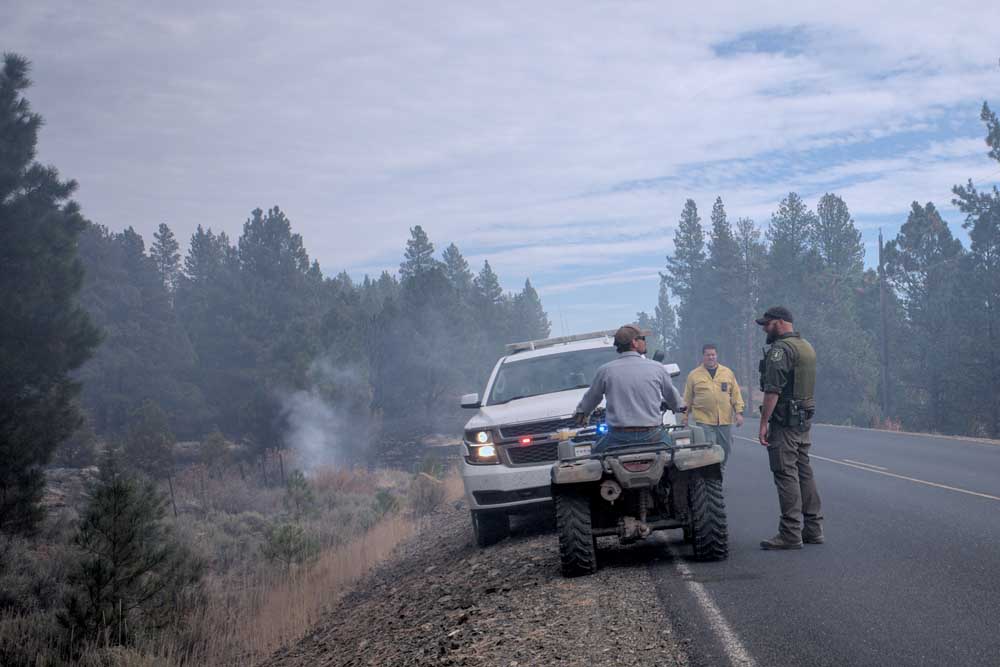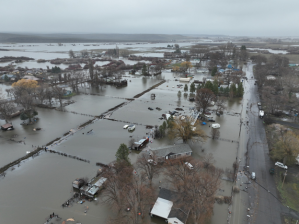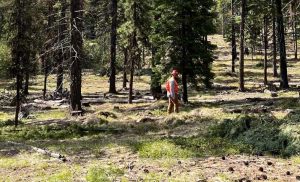Grant County sheriff threatened with arrest while arresting Forest Service burn boss
Published 6:15 am Wednesday, November 9, 2022

- Chad Holliday of Windy Point Ranch speaks with a Forest Service Law Enforcement and Investigations officer on the Izee-Paulina Highway on Oct. 20, 2022, the day after the arrest of a federal burn boss by Grant County Sheriff Todd McKinley.
BEAR VALLEY — New details in the arrest of a Forest Service burn boss during a prescribed burn in Grant County last month are raising the possibility that the sheriff who arrested him could in turn be subject to prosecution.
Trending
On Oct. 19 a prescribed burn being executed by the U.S. Forest Service, with help from Oregon Department of Forestry and contract crews, escaped the burn area, scorching approximately 18 acres of adjacent private land in Bear Valley, about 7 miles north of Seneca. While that “slopover” fire was actively being brought under control, Grant County Sheriff Todd McKinley, responding to a 911 call from the landowners, arrived on the scene and arrested Rick Snodgrass, the federal employee in charge of the operation, on a misdemeanor charge of reckless burning.
But a document obtained by the Blue Mountain Eagle shows that, in the course of arresting Snodgrass, McKinley was himself threatened with arrest for governmental obstruction, a potential felony charge under federal law.
In a sworn probable cause affidavit filed in court, McKinley gives a detailed account of events surrounding Snodgrass’ arrest for reckless burning. The sheriff describes a “tenuous and awkward situation” where the “conversation started going bad” once McKinley confronted Snodgrass.
Trending
“Fire Personnel were trying to tell me I was going to be arrested for Governmental Obstruction,” McKinley states in the affidavit.
The affidavit concludes with McKinley’s assessment that, as he drove off with Snodgrass in custody, “the fire was still not contained.”
The affidavit says that while McKinley was on the scene “landowners were requesting air support.” While air support had been authorized and planned for, the fire crews never called for it. The fire was ultimately brought under control using hand crews and a bulldozer within one hour of it being reported.
Arrest criticized
The incident attracted national attention, sparking discussions around prescription burning in general and bringing heavy criticism of the Grant County sheriff’s unprecedented action. Prior to these events, a federal firefighter had never been arrested in the course of performing their duties.
In the days following the incident, U.S. Forest Service Chief Randy Moore issued a statement defending Snodgrass and calling the arrest “highly inappropriate under these circumstances.” He went on to say he will “not stand idly by” and will defend all Forest Service employees carrying out their duties.
The National Federation of Federal Employees, a union representing 110,000 federal workers, including Forest Service personnel, went further in a statement issued on Nov. 2.
“It is not normal for a local sheriff to arrest a working fire commander during an incident,” wrote NFFE President Randy Erwin. “In doing so, the sheriff may have violated federal law that makes it a felony to interfere with a federal employee during their official duties, and the sheriff may have opened the county to massive liability for a civil rights violation for unlawfully detaining and removing (Snodgrass).”
McKinley confirmed that Snodgrass was one of the “firefighting personnel” he described as threatening him with arrest on the scene.
Whose authority?
Firefighters do not have the authority to make arrests, according to Lisa Ludwig, a criminal defense attorney who handles both state and federal cases. Ludwig said that threatening arrest without having that authority may be “talking out your ear” in the moment, but she went on to explain how it could still lead to federal charges down the line.
“A firefighter could act as an investigator or an agent of the government to write up a report and recommend a prosecution to a U.S. attorney,” who could choose to later pursue charges based on that investigation, Ludwig said.
She pointed out that some federal employees, such as park rangers, are given “quasi-law enforcement” authority and can issue citations. But she also said it was more likely that “they were giving their opinion that the sheriff could be arrested for what he was doing, not that they were claiming to have the power to arrest him.”
One Forest Service official said he understands it was less a threat of arrest and more a matter of firefighters “informing the sheriff of the consequences of his actions.”
Sheriff McKinley said that to his knowledge the matter “is not being pursued, though I’m not going to say it didn’t happen,” referring to the threat of arrest.
A Forest Service Law Enforcement and Investigations officer had been requested for the Oct. 19 burn. This was not a standard arrangement, according to current and retired Forest Service officials. The request was made directly in response to verbal harassment and perceived threats the crews had reported on the previous day of burn operations on Oct. 13. That law enforcement officer was not able to be on the scene due to an injury, but the burn went ahead.
Because that officer was not on scene, there was no law enforcement authority on the federal side when the sheriff arrived.
Ludwig describes a scenario in which federal and local law enforcement authorities could have “concurrent jurisdiction,” meaning both could arrest individuals if they had probable cause to believe a crime had been committed. She sees nothing that could prevent a sheriff from arresting a federal employee, which is exactly what happened. But given that the confrontation between McKinley and Snodgrass happened while both were in the process of carrying out their lawful duties, it could have gone the other way, with the sheriff being placed under arrest.
“If somebody interferes or obstructs (a federal officer), in general, that could lead to a federal charge,” Ludwig said.
Ludwig went on to describe the possibility of an “unfunny comedy” where a local and federal authority were trying to arrest each other. Even if the original arrest was unlawful, if the other authority tried to intervene, they could still be charged with resisting arrest, she explained.
McKinley’s affidavit claims that at one point Snodgrass “initially tried to pull his arm away from me. Once in custody, he calmed down some, and I moved the handcuffs to the front so he could sit more comfortably in the patrol vehicle.”
Qualified immunity
Grant County District Attorney Jim Carpenter, in a press release issued immediately following Snodgrass’ arrest, asserted that “the employer and/or position of Snodgrass will not protect him if it is determined that he acted recklessly. That the USFS was engaging in a prescribed burn may actually raise, rather than lower the standard to which Snodgrass will be held.”
Ludwig said this idea is based on the concept of a standard of care.
“Generally, it can vary depending on the circumstances and the individuals involved,” she said. “The standard of care for a phlebotomist is different from the standard of care for a doctor, even though they might both be setting an (IV) line, because their training and their role is different.” How this plays out is that there is an expectation that a government worker acts within the mandate and expectations of their job.
It could be difficult for the state to prove recklessness if conditions on the fire are shown to be within the prescription of the burn plan, which was years in the making. The Forest Service has maintained that the conditions on the day were within those set out in the burn plan, although the investigation into the Starr 6 fire continues and workers are under instructions to not comment on the matter further.
McKinley is also refusing to comment on the record, although he did express thoughts the day after the arrest to the industry blog Wildfire Today, in a recorded interview that was shared with the Eagle. In that interview, McKinley stated that “Everybody knew it was a bad burn, should not be happening — was not the right time to burn — and there may have even been means taken to get that burn done that were outside the scope.”
Federal officials and the Grant County Sheriff’s Office are continuing to investigate the incident, and the two are “sharing information.”
The legal doctrine of qualified immunity would likely shield both Snodgrass and McKinley against personal liability from lawsuits arising from their actions, as they were acting in their role as government agents. Only in very narrow circumstances can this protection be lifted. But that doctrine offers no such protection from criminal prosecution, and their respective employers remain open to civil liability.
The landowners have the ability to file a tort claim with the federal government for damages arising from the fire.







